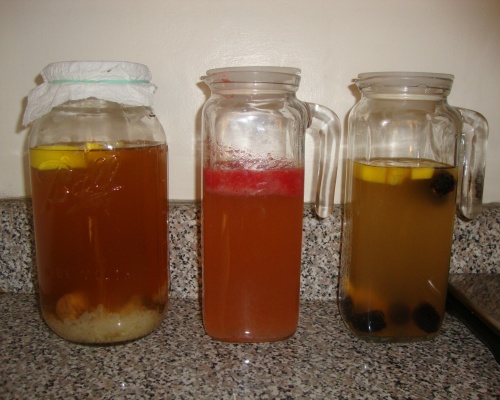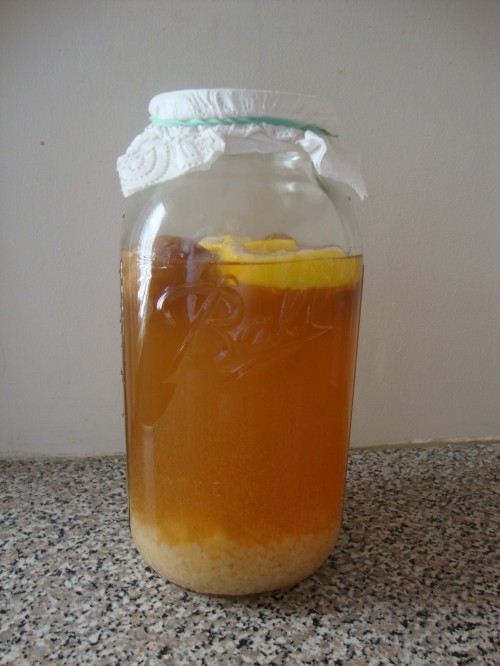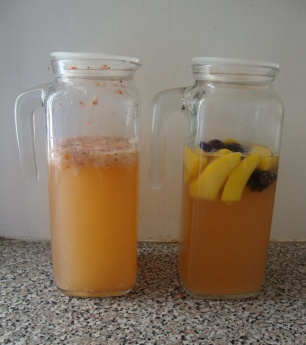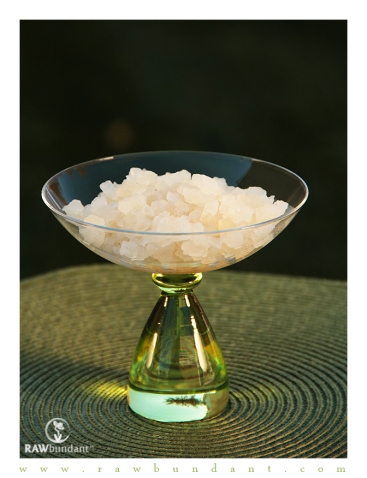Taken from http://zoevblog.com/2010/03/17/what-is-water-kefir-and-how-to-make-it/
I am very excited to tell you about a beverage that I have been
making for our family for a couple of months now. It’s called water
kefir. The best way to describe it is flavored soda minus all the
processed sugar, artificial colors, flavors and preservatives. Water
kefir is nature’s way of making soda and by far, one of the healthiest
and easiest to make at home. And because I love it so much, I spent the
time to write a detailed manual, as well as record two instructional
videos, on how you can make your own water kefir at home.
What is Water Kefir?
Water kefir is made from kefir grains, also known as sugar grains, tibicos, tibi, or Japanese water crystals.
The grains make up a cultures of various strains of healthy bacteria
and yeast, held together in a polysaccharide matrix created by the
bacteria. The symbiotic relationship of the microbes produces a stable
growing culture. The microbes feed on sugar and produce lactic acid,
alcohol (ethanol), and carbon dioxide, yielding a fermented carbonated
beverage. The alcohol content is usually very minimal, less than 1 %.
Water Kefir vs. Milk Kefir
There are two types of kefir grains – milk and water kefir grains.
Prior to making water kefir, I was making milk kefir using raw cow’s
milk. Though similar in function, milk grains are quite different than
water grains. They are white, cottage cheese-looking with slimy feel to
them. Water grains, however, are translucent, cauliflower-like and
easily break apart under pressure. Also, milk grains feed on the lactose
in milk whereas water grains feed on sugar.
Health Benefits of Water Kefir
The health benefits of consuming water kefir are endless. They are a
natural supplier of probiotics to our digestive tract. Probiotics refers
to the healthy bacteria that usually feeds on the “bad” unhealthy
bacteria in our stomach and intestines. Bacterial overgrowth can lead to
many illnesses some of which include fungi, yeast infections,
indigestion, obesity, Irritable Bowel Syndrome, Crohn’s Disease, skin
disorders, etc. By drinking water kefir you will bring balance to your
internal microflora. Many people take a probiotic supplement daily for
this particular reason but I prefer to drink the water kefir. It’s much
tastier and more affordable in the long run.
Dr. Gabriel Cousens, a leading expert in the raw food community, writes in his book “Rainbow Green Live Food Cuisine“:
“Kefir grains produce right-rotating L(+) lactic acid, which is
an important constituent of the human body. It is particularly important
in the prevention of cancer and has been used experimentally with
success in the treatment of cancer. In addition, right-rotating lactic
acid may help maintaining healthy functioning of the heart. According to
some researchers, the cells of the heart muscle obtain their energy
primarily from right-rotating lactic acid.”
Another health advantage of water kefir is that people who do not
wish to consume dairy or have a vegan type diet may find that water
kefir provides the living probiotics without the need for dairy or tea
cultured products, like kombucha.Vegans also may like to know that
through the fermentation process kefir becomes an excellent source of
vitamin B12, and is high in vitamins B1 and B6.
Diabetics, in particular, could greatly benefit from drinking kefir.
Since the finished product, if bottled, will produce a carbonated
beverage, it provides an alternative to sweet soda drinks. In that
sense, anyone from children to adults can enjoy water kefir guilt-free.
How to Make Water Kefir
Making water kefir is super easy and fun. To help illustrate the
process I have created two video tutorials – one on how to make the
basic water kefir recipe, and the other on how to make flavored water
kefir. You can watch them below.
Tools Required:
- Plastic strainer
- Plastic measuring spoons
- Plastic spoon
- Measuring cup
- 8-cup (1/2 gallon) Ball Mason jar
- 2-3 Glass pitchers or Ball Mason jars
Notes: it’s very important that you NEVER use
any metal utensils or tools when handling living cultures such as kefir
grains. They don’t like metal and may be adversely affected if exposed
to it.
Ingredients needed:
- Filtered or spring water
- Water kefir grains
- Organic cane sugar
- Sucanat, raw sugar or coconut palm sugar
- Unsweetened, unsulfured dried fruit (apricots, figs or raisins)
- Organic lemon (optional)
Notes: never use tap water because it contains
chemicals such as chlorine and fluoride. They will kill the grains. Make
sure the dried fruit doesn’t have any sulfur dioxide added to it. Many
conventional brands add this chemical to keep the dried fruit looking
bright and fresh.
Basic water kefir formula:
- 1 Cup of water
- 1 Tbsp. of sugar
- 1 Tbsp. of kefir grains
- Few pieces of dried fruit
Notes: The ratio of 1-1-1 is what you need to follow.
My video tutorial recipe:
- 6 Cups of water
- 6-8 Tbsp. kefir grains
- 4 Tbsp. organic cane sugar
- 2 Tbsp. coconut palm sugar
- 4 pieces of dried apricots and figs
- 2 lemon wedges
Notes: When dividing the sugar always add more
organic cane sugar and less sucanat, raw or coconut palm sugar. Kefir
grains thrive primarily on the organic cane sugar. The other sugar and
dried fruit are added to give them additional nutritional support their
growth.

New batch of plain water kefir and flavored water kefir prior to fermentation.
The fermentation process
After all the ingredients are in the jar, you need to cover the top
of the jar with a cloth, paper towel or parchment paper held by elastic.
This is so your kefir grains can breathe and to make sure nothing can
contaminate them. Putting a tight lid could cause the jar to explode
due to the natural carbonation process taking place.
Place the water kefir jar on your counter away from direct sunlight. The kefir water should be ready in 24-48 hours. The
kefir will be mild and sweet at 24 hours, and more zesty and acidic at
48 hours. This is really a matter of personal preference and either way
is tasty and has health benefits. Temperature can speed this process up
the warmer it is inside your house. If it tastes like there is too much
alcohol for you try reducing the amount of sugar and fruit or reduce the
amount of grains. You will soon find what you like after a couple taste
tests.

The same batch after 24 hours of fermentation.

Plain
water kefir after 24 ours of fermentation. Notice how the fruit has
risen to the top. That's because it's filled with tiny molecules of CO2,
making it lighter. You will also notice bubbles if you lightly shake
the jar. Those are signs that your water kefir is ready to drink.
How to Make Flavored Water Kefir
This is where the fun part of making water kefir comes because you can customize the flavor to your liking. Follow this steps:
- After the initial batch of plain water kefir has fermented, drain the kefir water and set the grains aside for a new batch.
- Take the fermented kefir water and pour into a large glass pitcher or a couple small pitchers, pending how many flavors you’d like to make.
- To each pitcher/jar add 1/4 cup of fruit juice or fresh fruit of your choice. If you are making Strawberry Lemonade (as I have made in my video tutorial) make sure to puree the strawberries first. It will give your kefir much richer taste.
- Let the kefir ferment for another 24 hours. This time you can put a tight lid especially if you prefer more fizz to your beverage.
- In 24 hours you will notice color change in your kefir as the flavor of the fruit/juice is metabolized by the kefir grains. Taste your kefir to see if it’s ready. If it’s not sweet enough, just add a tablespoon of sugar.
- Take your final water kefir, pour over ice and enjoy!


- The flavored water kefir after 48 hours of fermentation.
Flavored Water Kefir Recipes
Coconut Water Kefir
If you love coconut water, then making it into kefir is even better! Just substitute the water portion with fresh coconut water from Young Thai coconuts. Those can be found at Asian markets and cost about $1.99. You will need about 6-8 coconuts to get 6 cups of coconut water. You do not need to add sugar to the mix because coconut water is naturally sweet and it will feed the grains on its own. Also, you may skip the dried fruit and lemon.
If you love coconut water, then making it into kefir is even better! Just substitute the water portion with fresh coconut water from Young Thai coconuts. Those can be found at Asian markets and cost about $1.99. You will need about 6-8 coconuts to get 6 cups of coconut water. You do not need to add sugar to the mix because coconut water is naturally sweet and it will feed the grains on its own. Also, you may skip the dried fruit and lemon.
Creamy Ginger Spice
After 24 hours of fermentation with just ginger and sugar, strain the kefir, take the liquid and add ½ Tb. vanilla extract and 1 cinnamon stick per quart. Let sit for another 24 hours on the counter, or 24-48 in the fridge. Tighten the lid for more fizz! Serve cold with whip cream on top. Or add some scoops of caramel vanilla ice cream for a delicious float!
After 24 hours of fermentation with just ginger and sugar, strain the kefir, take the liquid and add ½ Tb. vanilla extract and 1 cinnamon stick per quart. Let sit for another 24 hours on the counter, or 24-48 in the fridge. Tighten the lid for more fizz! Serve cold with whip cream on top. Or add some scoops of caramel vanilla ice cream for a delicious float!
Lime Pineapple
After 24 hours of fermentation with a slice of lime (instead of lemon), strain the kefir, take the liquid and add a half cup pineapple chunks per quart, squeeze in the lime juice and discard the lime slice. Let sit for another 24 hours on the counter, or 24-48 in the fridge.
After 24 hours of fermentation with a slice of lime (instead of lemon), strain the kefir, take the liquid and add a half cup pineapple chunks per quart, squeeze in the lime juice and discard the lime slice. Let sit for another 24 hours on the counter, or 24-48 in the fridge.
Raspberry Mango
After 24 hours of fermentation, strain the kefir, take the liquid and add ¼ cup mango (or similar tropical fruit juice) per quart. Add in ½ cup raspberries. Let sit for another 24 hours on the counter, or 24-48 in the fridge. Tighten the lid for more fizz!
After 24 hours of fermentation, strain the kefir, take the liquid and add ¼ cup mango (or similar tropical fruit juice) per quart. Add in ½ cup raspberries. Let sit for another 24 hours on the counter, or 24-48 in the fridge. Tighten the lid for more fizz!
Strawberry Lemon
After 24 hours of fermentation, strain the kefir, take the liquid and add 1/2 cup purred strawberries and squeeze out the juice from the lemon into it. Add a couple whole strawberries if desired as well. Let sit for another 24 hours on the counter, or 24-48 in the fridge. If this is too tart, add in some sugar or honey at the end to taste.
After 24 hours of fermentation, strain the kefir, take the liquid and add 1/2 cup purred strawberries and squeeze out the juice from the lemon into it. Add a couple whole strawberries if desired as well. Let sit for another 24 hours on the counter, or 24-48 in the fridge. If this is too tart, add in some sugar or honey at the end to taste.
Cola Cherry
After 24 hours of fermentation of just sugar and grains, strain the kefir, take the liquid and add ¼ cup cherry juice per quart. Add a couple whole cherries if desired as well. Let sit for another 24 hours on the counter, or 24-48 in the fridge. Mix in sugar to taste if desired.
After 24 hours of fermentation of just sugar and grains, strain the kefir, take the liquid and add ¼ cup cherry juice per quart. Add a couple whole cherries if desired as well. Let sit for another 24 hours on the counter, or 24-48 in the fridge. Mix in sugar to taste if desired.
Storing Extra Kefir Grains
After your first few batches you will notice that your kefir grains
grow rapidly (considering you take good care of them). You can do four
things with the extra grains:
- Eat them! They are very nutritious, packed with many beneficial probiotic bacteria. You can add them to your smoothies if you wish.
- Short-term storage – you can store water kefir grains in sugary water in the refrigerator for up to a week. The cold temperature will slow down their growth. Just make sure to rinse and change their water on weekly basis.
- Long-term storage – you can put the extra grains in a glass jar and freeze them. They can last for about 6 months or longer. Keep in mind that it may take a few batches to revive them after they’ve been frozen. They should be fine after that.
- Share them! As you accumulate more water kefir grains, just
share the joy of making water kefir with family and friends. Give them
your extra grains and teach them how to make their own natural “soda” at
home.

Final Notes
Water kefir contains very large amounts of good bacteria and yeast as
well as being high acidic. For some people it can be a little bit of a
shock. Everybody reacts to it differently, so we always recommend
starting out slow to see how your body takes to it. The majority of
people do not have any adverse reaction, but if you do, usually it’s
just a matter of starting out slow and slowing increasing over time.
Start with a tablespoon and go from there. Sometimes drinking in the
morning is best as many people report that they do much better with
kefir in the morning.
If you are interested in more fermented probiotics food, check out my blog “Making Fermented Feta Cheeze Without Milk!”
That’s it! You are now ready to make your own water kefir at home. 
P.S. Some of the tips, recipes and advice has been taken from Yemoos Nourishing Cultures water kefir guide. Thank you for their help and for sharing that information with us.
Copyright © 2010 Zoe V. All Rights Reserved

No comments:
Post a Comment
Reply to message